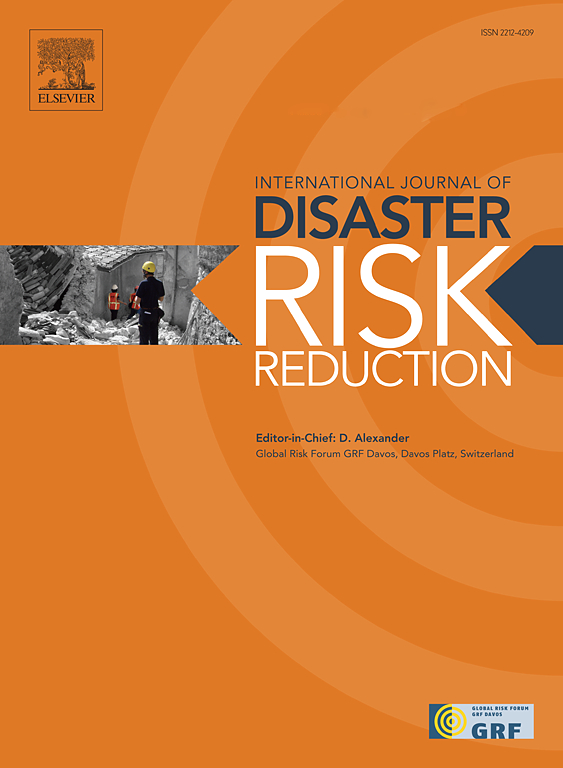评估和减轻极端降水导致的住宅倒塌风险:使用 CNN-RF 和 GeoDetector 的综合研究
IF 4.2
1区 地球科学
Q1 GEOSCIENCES, MULTIDISCIPLINARY
International journal of disaster risk reduction
Pub Date : 2024-11-01
DOI:10.1016/j.ijdrr.2024.104918
引用次数: 0
摘要
龙舟雨是华南地区 5 月至 6 月最常见的极端降水形式,空间分布较为相似,给人民生命财产造成了严重损失。住宅倒塌是主要损失之一。以往的研究很少关注龙舟雨(DCRDBR)导致的民房倒塌风险、应用 CNN 和 RF 耦合模型对其进行评估,以及降水过程和自然与社会因素相互作用对其的影响。为了填补这些空白,利用 CNN-RF 计算了龙舟雨风险,并绘制了龙舟雨风险地图。由于 DCRDBR 的空间分层异质性,以及能够获得单因素和因素交互作用的决定力,因此使用 Geodetctor 确定了 DCRDBR 的主要影响因素和影响因素交互作用。结果表明,CNN-RF 的 F1 得分和 AUC 值分别为 0.96 和 0.81。CNN-RF 得到的 DCRDBR 空间分布在广东省东北部较高,西南部较低。总降水量的决定力最强(q = 0.54),其次是坡度(q = 0.52)。描述降水过程的因子的平均决定力为 0.25。在所有自然和社会经济因素组合中,总降水量和人均国内生产总值的组合具有最强的决定力(q = 0.72),其次是总降水量和城市人口比例(q = 0.71)。本研究证明了 CNN-RF 在 DCRDBR 评估中的应用能力,它集特征提取和抗过拟合能力于一体,识别了降水过程以及自然和社会经济因素的相互作用对 DCRDBR 的影响。它为制定减轻龙舟雨影响的策略提供了坚实的科学依据,有利于城市的可持续发展。本文章由计算机程序翻译,如有差异,请以英文原文为准。
Assessing and mitigating dwelling collapse risk due to extreme precipitation: A comprehensive study using CNN-RF and GeoDetector
Dragon boat rain, the most common extreme precipitation form in South China from May to June with more similar spatial distribution, caused serious loss of people's lives and property. The dwelling collapse is one of the main losses. Previous studies have paid little attention to the dwelling collapse risk caused by dragon boat rain (DCRDBR), the coupling model with CNN and RF applied to its assessment, and the influence of the precipitation process and interaction of natural and social factors on it. To fill these gaps, the CNN-RF was used to calculate the DCRDBR and the DCRDBR map was drawn. The Geodetctor was used to identify the main influencing factors and influencing factor interactions of DCRDBR, due to the spatial stratified heterogeneity of DCRDBR and the ability to obtain the determinant power of single factor and factor interaction. The results show that the F1 score and the AUC value of CNN-RF are 0.96 and 0.81, respectively. The spatial distribution of DCRDBR obtained by CNN-RF is high in the northeast and low in the southwest Guangdong Province. The total precipitation has the strongest determinant power (q = 0.54) followed by Slope (q = 0.52). The average determinant power of factors describing the precipitation process is 0.25. The combination of total precipitation and GDP/capita has the strongest determinant power of all combinations of natural and socio-economic factors (q = 0.72) followed by the total precipitation and ratio of urban population (q = 0.71). This study demonstrates the ability of CNN-RF applied to the DCRDBR assessment due to the integration of feature extraction and anti-overfitting ability, and identifies the influence of precipitation processes and the interaction of natural and socio-economic factors on the DCRDBR. It provides a solid scientific basis for crafting strategies to mitigate the impact of dragon boat rain and is conducive to the city's sustainable development.
求助全文
通过发布文献求助,成功后即可免费获取论文全文。
去求助
来源期刊

International journal of disaster risk reduction
GEOSCIENCES, MULTIDISCIPLINARYMETEOROLOGY-METEOROLOGY & ATMOSPHERIC SCIENCES
CiteScore
8.70
自引率
18.00%
发文量
688
审稿时长
79 days
期刊介绍:
The International Journal of Disaster Risk Reduction (IJDRR) is the journal for researchers, policymakers and practitioners across diverse disciplines: earth sciences and their implications; environmental sciences; engineering; urban studies; geography; and the social sciences. IJDRR publishes fundamental and applied research, critical reviews, policy papers and case studies with a particular focus on multi-disciplinary research that aims to reduce the impact of natural, technological, social and intentional disasters. IJDRR stimulates exchange of ideas and knowledge transfer on disaster research, mitigation, adaptation, prevention and risk reduction at all geographical scales: local, national and international.
Key topics:-
-multifaceted disaster and cascading disasters
-the development of disaster risk reduction strategies and techniques
-discussion and development of effective warning and educational systems for risk management at all levels
-disasters associated with climate change
-vulnerability analysis and vulnerability trends
-emerging risks
-resilience against disasters.
The journal particularly encourages papers that approach risk from a multi-disciplinary perspective.
 求助内容:
求助内容: 应助结果提醒方式:
应助结果提醒方式:


